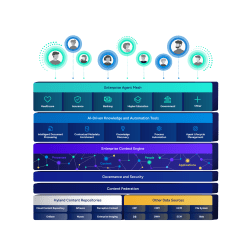Migrating from an on-premises solution to the Hyland Cloud
Hyland’s migration structure is designed to minimize downtime and interruption to your organization's processes regardless of the complexity of your solution.

Harness the power of a unified content, process and application intelligence platform to unlock the value of enterprise content.
Learn more
Automate your document-centric processes with AI-powered document capture, separation, classification, extraction and enrichment.
Learn about Hyland IDPIt's your unique digital evolution … but you don't have to face it alone. We understand the landscape of your industry and the unique needs of the people you serve.
 Overview of industries
Overview of industries
Countless teams and departments have transformed the way they work in accounting, HR, legal and more with Hyland solutions.
 Overview of departments
Overview of departments
We are committed to helping you maximize your technology investment so you can best serve your customers.
 Overview of services
Overview of services

Discover why Hyland is trusted by thousands of organizations worldwide.
Hear from our customers
Our exclusive partner programs combine our strengths with yours to create better experiences through content services.
Overview of partners
Find resources to power your organization's digital transformation.
Browse the resource center
Hyland connects your content and systems so you can forge stronger connections with the people who matter most.
Learn about HylandWith our modern, open and cloud-native platforms, you can build strong connections and keep evolving.
 Dig deeper
Dig deeper
Through numerous customer migrations, Hyland has fine-tuned our migration process to make the process as smooth as possible.
We're making a few assumptions about your solution when we talk about this general migration process.
We assume:
If any of these three things don’t apply to your solution, it’s not a problem.
We might just need a different discussion about how best to customize your migration.
Related articles
Make sure to include:
Remember what you shared with Hyland, especially with disk groups. You don’t want to send duplicate data during updates before “go live.” Avoid this by promoting them all just prior to database backup.
Once Hyland has the data, we’ll start setting up its new home in our cloud.
Your cloud solution is ready for testing, so get in there and test away. Track your changes and we’ll track ours, then together we will apply those changes during “go live.”
While we’re testing the solution, you can upload data, i.e. disk groups, as you continue to use your on-premises solution. And we want you to. This helps ensure the smallest amount of final data possible when it’s time to “go live.” Keeping disk groups up-to-date in the Hyland Cloud will greatly benefit the “go live” schedule.
Once all testing is complete and the solution is working as expected, we’ll schedule the “go live” date. Note that during the “go live” process, your production solution will need to be offline.
Hyland will try to accommodate the most convenient time for you when we schedule the “go live” — including nights and weekends — to minimize day-to-day disruptions.
We know you’re excited to launch your solution; or you might believe that setting a deadline will help motivate the team to complete work faster. Experience has taught us to recommend that you wait until testing is complete before setting a “go live” date. This avoids schedule changes due to unforeseen delays.
There are a couple of things we need to do before we can go live.
The data’s received, the final disk groups are in place, the database is restored and we’ve made all the changes noted during the initial testing phase. Before we go live, this is a good time to give the solution one last look.
Let’s give the solution one last round of testing to make sure everything is operating as expected.
We did it. We went through all the steps necessary to make the move from an on-premises solution to one hosted in the Hyland Cloud. Now you can reap all the benefits of this strategic decision:
A quick overview of the Hyland cloud migration process for your reference:

This video provides an overview of the Hyland Cloud Foundation, including: Why you should host in the Hyland Cloud; what sets us apart; the platform and our datacenters; the Hyland teams and responsibilities; and the Hyland Cloud services classes and compliance.
